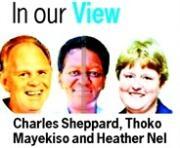
THE equity index (EI) study conducted by University of KwaZulu-Natal researchers is rightfully generating much-needed debate within the higher education sector about the pace of transformation at South African universities. The EI measured the distance between university student and staff demographics as compared to national demographics.
The statistics produced by this study are used to argue that the rate of transformation has been painfully slow and the much-lauded autonomy afforded to this sector has clearly not been used to transform itself.
Although South African higher education institutions still have a road to travel as it relates to transformation, there is also room for celebration. For while the UKZN study argues a particular concern is the efficiency of the sector in producing graduates in line with the equity profile of the enrolled students, an analysis of higher education data indicates that African and coloured student enrolments grew on average by 6.9% and 4.1% respectively per year during the period 2005-12, while graduates grew on average by 6.9% and 5.8% respectively per year during the same timeframe.
This is an indication of improved efficiency since black graduates are being produced at a slightly higher rate than they are being enrolled at universities. Furthermore, if you disaggregate the total head count enrolments of the higher education system (953 373 students last year compared to 120 385 in 2005), 70% were African and 6% were coloured last year compared to 61% and 6% respectively in 2005.
Similar improvements have occurred as it relates to graduates, with African and coloured graduates accounting for 64% and 6% respectively of all graduates last year compared to 55% and 6% respectively in 2005.
With specific reference to NMMU, contact student enrolments and graduation rates of black students have also been improving since 2005. African and coloured contact student enrolments at NMMU have increased at an average annual rate of 4.2% and 3.5% respectively between 2005 and last year, while graduates improved by 5.1% and 4.1% respectively during the same timeframe.
This has resulted in a student equity profile where African and coloured students constitute 74% of all contact student enrolments at NMMU and 71% of all contact students who graduate from the university, compared to 68% and 64% respectively in 2005.
The UKZN study is also found wanting on a number of other fronts, most notably the snapshot of higher education transformation (by using 2011 data) instead of tracking progress made since 1994. Secondly, it highlights the link between research and equity, but fails to analyse who is actually producing the research outputs at the universities that are categorised as having good research productivity.
Ask yourself: what is the relevance of research productivity in the transformation of our country if research outputs are mostly produced by white males over the age of 55?
A significant shortfall of the EI is that the data were not normed to take into consideration the size of universities. A university with more instruction/research staff will produce more research outputs.
This, for example, explains why Rhodes University is indicated as having poor research productivity in spite of a high publication rate when compared to universities of a comparable size in the system.
As a result, the study is not comparing apples with apples when it categorises universities in terms of equity indices and research productivity. The study also narrowly equates knowledge production with research publications and masters and doctoral graduate outputs, and overlooks other forms of knowledge production and innovation generated by universities of technology and comprehensive universities.
If you truly want to assess the contribution of higher education to transformation then it would be preferable to complement the EI study with more statistically robust data trends analyses across a number of appropriate performance indicators to assess progress, or lack thereof, in achieving more diverse staff and student equity profiles.
Comparisons of progress should be done relative to the national average across the sector while considering the different nature of each university. For example, the EI categorises NMMU as having poor research productivity despite its research outputs having exceeded the national average in 2010 and 2011.
In conclusion, any assessment of higher education transformation would be incomplete if it did not foreground a holistic conceptualisation of transformation which includes, but is not limited to, student and staff demographic profiles. In analysing the progress of the higher education sector in achieving transformational goals, some pertinent questions need to be asked of universities. Are they, for example:
- Creating an enabling and humanising institutional climate where diversity is affirmed as powerful wellspring for personal, intellectual and institutional development?
- Effectively implementing teaching and learning approaches that are effective in developing graduates who are enlightened, responsible and constructively critical citizens?
- Embarking on curriculum innovation to meet the graduate needs of the economy and society while also celebrating diverse knowledge traditions and paradigms?
- Inducting previously excluded social groups such as black and women academics into the production and dissemination of knowledge?
- Challenging dominant discourses to promote social cohesion and social justice, promote human dignity and rights, and enhance respect for diversity?
- Affirming the value of indigenous knowledge systems and African languages with consequences for the promotion of multilingualism?
Thoko Mayekiso is deputy vice-chancellor research and engagement, Heather Nel senior director of institutional planning and Charles Sheppard director of management information at NMMU. The views expressed are those of the authors and not the official view of the university.
Caption: Charles Sheppard, Thoko Mayekiso and Heather Nel
Source: The Herald newspaper
